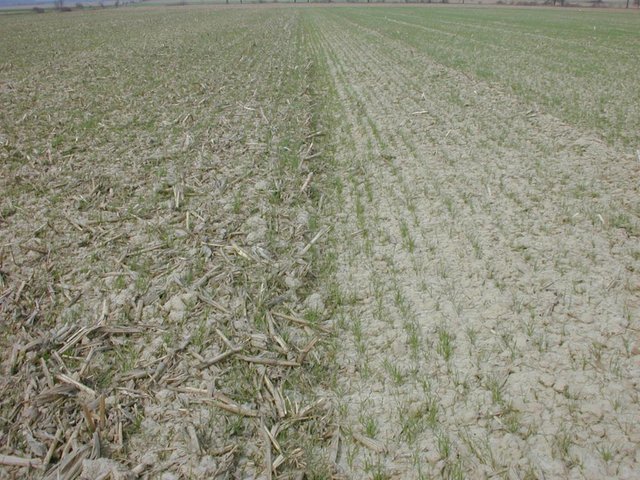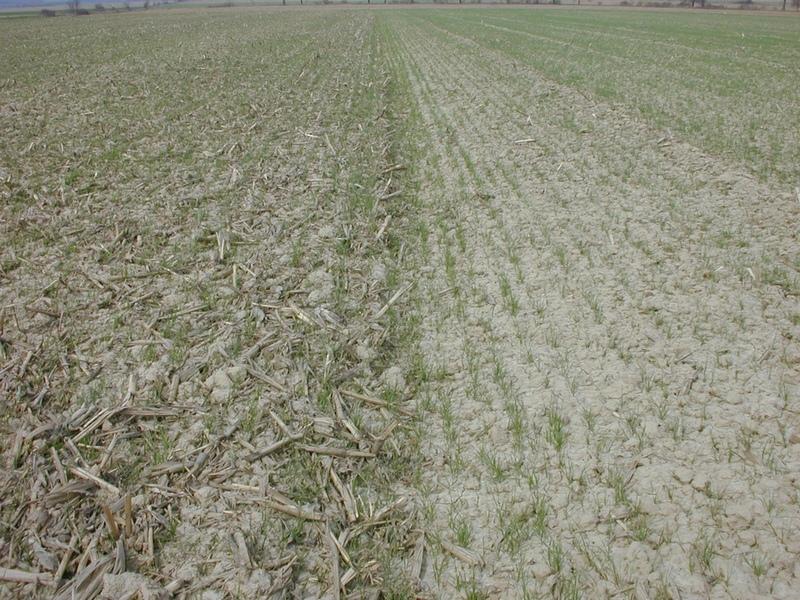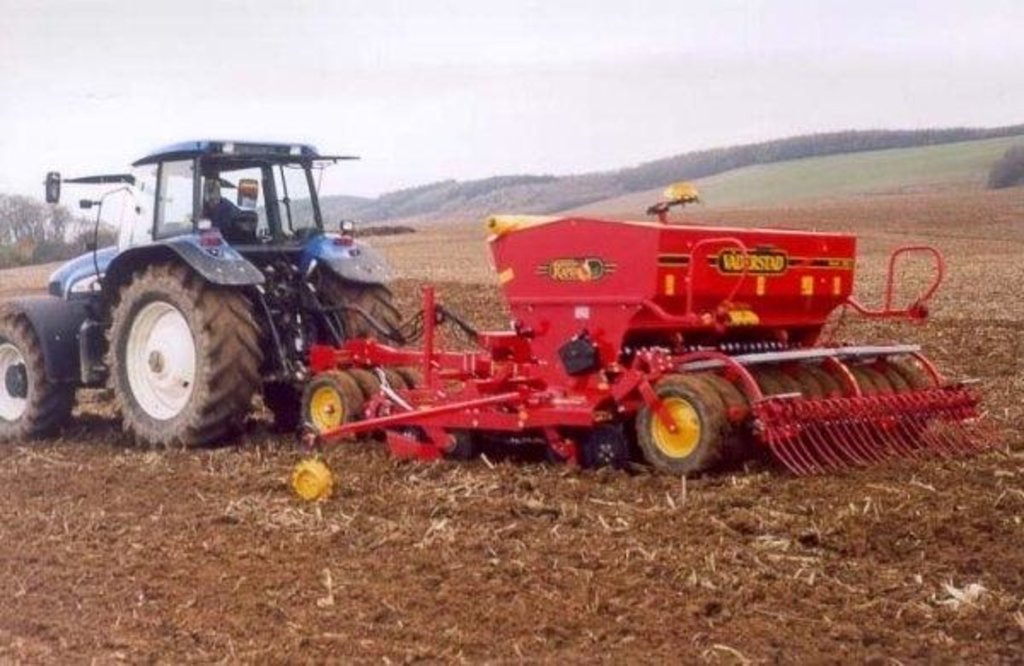Conservation tillage [Hungary]
- Creation:
- Update:
- Compiler: Ádám Kertész
- Editor: –
- Reviewers: David Streiff, Alexandra Gavilano
talajkímélö földmüvelés (Hungarian)
technologies_1080 - Hungary
View sections
Expand all Collapse all1. General information
1.2 Contact details of resource persons and institutions involved in the assessment and documentation of the Technology
SLM specialist:
SLM specialist:
Csepinszky Béla
Geographical Research Institute, Hungarian Academy of Sciences
Hungary
Name of project which facilitated the documentation/ evaluation of the Technology (if relevant)
Soil and water protection (EU-SOWAP)Name of the institution(s) which facilitated the documentation/ evaluation of the Technology (if relevant)
Geographical Research Institute, Hungarian Academy of Sciences (MTA CSFK) - Hungary1.3 Conditions regarding the use of data documented through WOCAT
The compiler and key resource person(s) accept the conditions regarding the use of data documented through WOCAT:
Yes
1.5 Reference to Questionnaire(s) on SLM Approaches (documented using WOCAT)

Conservation tillage [Hungary]
Non inversion, conservation (soil and water protective) tillage.
- Compiler: Adam Kertesz
2. Description of the SLM Technology
2.1 Short description of the Technology
Definition of the Technology:
Non inversion, conservation (soil and water protective) tillage.
2.2 Detailed description of the Technology
Description:
According to our understanding conventional agriculture is based on tillage and it is highly mechanised. Conventional agriculture causes severe land degradation problems including soil erosion and pollution as well as other environmental damages like biodiversity and wildlife reduction, low energy efficiency and a contribution to global warming. Conservation Agriculture is a holistic approach to crop production, which encompasses "Conservation Tillage", and also seeks to preserve biodiversity in terms of both flora and fauna. Activities such as Integrated Crop, Weed, and Pest Management form part of Conservation Agriculture. The concept of "As little as possible, as much as is needed" will be the guiding principles for SOWAP in crop production, when it comes to chemical usage.
Purpose of the Technology: inding and Demonstrating Ways of Better Managing the Land. SOWAP (SOil and WAter Protection - supported by the EU LIFE Programme and by Syngenta) aims to assess the viability of a more "conservation-oriented" agriculture, where fewer tillage practices replace the numerous cultivations carried out under more "conventional" arable farming systems. The use of appropriate chemicals is tested, and their potential for off-site contamination assessed, to ensure that any suggested approaches are environmentally sound.
Establishment / maintenance activities and inputs: The SOWAP project started on study sites in Belgium, Czech Republik, Hungary and United Kingdom. I Hungary 3 sites were selected near Lake Balaton. One of them is Dióskál (2). There are 4 conservation and 4 conventional tilled plots, each between 3-5 Ha in size. The project has benn started in 2003.
2.3 Photos of the Technology
2.5 Country/ region/ locations where the Technology has been applied and which are covered by this assessment
Country:
Hungary
Region/ State/ Province:
Zala county
Further specification of location:
Zala county, Zala-hills, Zala
Specify the spread of the Technology:
- evenly spread over an area
If the Technology is evenly spread over an area, specify area covered (in km2):
0.2012
Comments:
Total area covered by the SLM Technology is 0.2012 km2.
Map
×2.6 Date of implementation
If precise year is not known, indicate approximate date:
- less than 10 years ago (recently)
2.7 Introduction of the Technology
Specify how the Technology was introduced:
- during experiments/ research
Comments (type of project, etc.):
The technology came from England, nevetheless it is known among the Hungarian SWC specialists before.
3. Classification of the SLM Technology
3.1 Main purpose(s) of the Technology
- reduce, prevent, restore land degradation
- preserve/ improve biodiversity
3.2 Current land use type(s) where the Technology is applied

Cropland
- Annual cropping
Annual cropping - Specify crops:
- cereals - maize
- cereals - wheat (winter)
Number of growing seasons per year:
- 1
Specify:
Longest growing period in days: 185; Longest growing period from month to month: Apr - Oct
Is crop rotation practiced?
Yes
If yes, specify:
Rotations / fallows: wheat/maize
Comments:
Major land use problems (compiler’s opinion): Fine loess soil with significant soil degradation, soil compaction due to inconvenient land use
Major land use problems (land users’ perception): EU and government rules, problems of the subsidy system, sales and marketing concerns
Type of cropping system and major crops comments: maize, winter wheat, maize…
3.4 Water supply
Water supply for the land on which the Technology is applied:
- rainfed
3.5 SLM group to which the Technology belongs
- minimal soil disturbance
3.6 SLM measures comprising the Technology

agronomic measures
- A2: Organic matter/ soil fertility
- A3: Soil surface treatment

management measures
- M2: Change of management/ intensity level
Comments:
Secondary measures: management measures
Type of agronomic measures: relay cropping, mulching, mineral (inorganic) fertilizers, rotations / fallows, minimum tillage, contour tillage, breaking compacted subsoil
3.7 Main types of land degradation addressed by the Technology

soil erosion by water
- Wt: loss of topsoil/ surface erosion
- Wo: offsite degradation effects

soil erosion by wind
- Et: loss of topsoil

chemical soil deterioration
- Cn: fertility decline and reduced organic matter content (not caused by erosion)
- Cp: soil pollution

physical soil deterioration
- Pk: slaking and crusting
- Pi: soil sealing

water degradation
- Ha: aridification
Comments:
Secondary types of degradation addressed: Wo: offsite degradation effects, Et: loss of topsoil, Cn: fertility decline and reduced organic matter content, Cp: soil pollution
Main causes of degradation: other natural causes (avalanches, volcanic eruptions, mud flows, highly susceptible natural resources, extreme topography, etc.) specify (natural soil compaction)
3.8 Prevention, reduction, or restoration of land degradation
Specify the goal of the Technology with regard to land degradation:
- prevent land degradation
4. Technical specifications, implementation activities, inputs, and costs
4.1 Technical drawing of the Technology
Technical specifications (related to technical drawing):
Technical knowledge required for field staff / advisors: moderate
Technical knowledge required for land users: high
Main technical functions: control of dispersed runoff: impede / retard, improvement of ground cover, improvement of soil structure
Secondary technical functions: control of raindrop splash, control of concentrated runoff: impede / retard, increase in organic matter, increase of infiltration, increase / maintain water stored in soil
Relay cropping
Material/ species: wheat, maize
Mulching
Material/ species: stem remains
Mineral (inorganic) fertilizers
Material/ species: NPK
Rotations / fallows
Material/ species: wheat/maize
Other type of management: change of cultivation method( (non inversion), changing the depth of cultivation
4.2 General information regarding the calculation of inputs and costs
other/ national currency (specify):
Hungarian Forint HUF
If relevant, indicate exchange rate from USD to local currency (e.g. 1 USD = 79.9 Brazilian Real): 1 USD =:
195.8
Indicate average wage cost of hired labour per day:
25.50
4.3 Establishment activities
| Activity | Timing (season) | |
|---|---|---|
| 1. | Ploughing (yearly) | autumn |
4.5 Maintenance/ recurrent activities
| Activity | Timing/ frequency | |
|---|---|---|
| 1. | Minimum tillage | spring and autumn / after harvest |
| 2. | non inversion, minimum tillage, shallow tillage | autumn / 1x -2x |
| 3. | if needed loosening | early autumn / only if needed |
4.6 Costs and inputs needed for maintenance/ recurrent activities (per year)
Comments:
Machinery/ tools: powerful tractor, disk, direct drill, harvester, sprayer, cultivator
4.7 Most important factors affecting the costs
Describe the most determinate factors affecting the costs:
wet weather>get weedy; compacted soil surface>(loosening) chiselling
5. Natural and human environment
5.1 Climate
Annual rainfall
- < 250 mm
- 251-500 mm
- 501-750 mm
- 751-1,000 mm
- 1,001-1,500 mm
- 1,501-2,000 mm
- 2,001-3,000 mm
- 3,001-4,000 mm
- > 4,000 mm
Specify average annual rainfall (if known), in mm:
650.00
Agro-climatic zone
- sub-humid
5.2 Topography
Slopes on average:
- flat (0-2%)
- gentle (3-5%)
- moderate (6-10%)
- rolling (11-15%)
- hilly (16-30%)
- steep (31-60%)
- very steep (>60%)
Landforms:
- plateau/plains
- ridges
- mountain slopes
- hill slopes
- footslopes
- valley floors
Altitudinal zone:
- 0-100 m a.s.l.
- 101-500 m a.s.l.
- 501-1,000 m a.s.l.
- 1,001-1,500 m a.s.l.
- 1,501-2,000 m a.s.l.
- 2,001-2,500 m a.s.l.
- 2,501-3,000 m a.s.l.
- 3,001-4,000 m a.s.l.
- > 4,000 m a.s.l.
Comments and further specifications on topography:
Altitudinal zone: ~ 200 m
5.3 Soils
Soil depth on average:
- very shallow (0-20 cm)
- shallow (21-50 cm)
- moderately deep (51-80 cm)
- deep (81-120 cm)
- very deep (> 120 cm)
Soil texture (topsoil):
- medium (loamy, silty)
Topsoil organic matter:
- medium (1-3%)
If available, attach full soil description or specify the available information, e.g. soil type, soil PH/ acidity, Cation Exchange Capacity, nitrogen, salinity etc.
Soil fertility is medium
Soil drainage / infiltration is good
Soil water storage capacity is medium and sometimes high
5.6 Characteristics of land users applying the Technology
Market orientation of production system:
- commercial/ market
Off-farm income:
- less than 10% of all income
Relative level of wealth:
- average
Level of mechanization:
- mechanized/ motorized
Indicate other relevant characteristics of the land users:
Population density: 50-100 persons/km2
Annual population growth: negative
100% of the land users are average wealthy and own 100% of the land.
Off-farm income specification: They have no off-farm incomes.
5.7 Average area of land used by land users applying the Technology
- < 0.5 ha
- 0.5-1 ha
- 1-2 ha
- 2-5 ha
- 5-15 ha
- 15-50 ha
- 50-100 ha
- 100-500 ha
- 500-1,000 ha
- 1,000-10,000 ha
- > 10,000 ha
Comments:
Also 100-500 ha, 500-1,000 ha
5.8 Land ownership, land use rights, and water use rights
Land ownership:
- individual, titled
Land use rights:
- individual
6. Impacts and concluding statements
6.1 On-site impacts the Technology has shown
Socio-economic impacts
Production
crop production
Income and costs
farm income
Other socio-economic impacts
input contstraints
Socio-cultural impacts
SLM/ land degradation knowledge
Ecological impacts
Soil
soil moisture
soil loss
Quantity before SLM:
0.2
Quantity after SLM:
0
soil organic matter/ below ground C
Other ecological impacts
biodiversity
soil fertility
soil structure
6.2 Off-site impacts the Technology has shown
downstream flooding
downstream siltation
groundwater/ river pollution
6.4 Cost-benefit analysis
How do the benefits compare with the establishment costs (from land users’ perspective)?
Short-term returns:
neutral/ balanced
Long-term returns:
neutral/ balanced
How do the benefits compare with the maintenance/ recurrent costs (from land users' perspective)?
Short-term returns:
neutral/ balanced
Long-term returns:
neutral/ balanced
6.5 Adoption of the Technology
- single cases/ experimental
If available, quantify (no. of households and/ or area covered):
1 household
Of all those who have adopted the Technology, how many did so spontaneously, i.e. without receiving any material incentives/ payments?
- 0-10%
Comments:
100% of land user families have adopted the Technology with external material support
1 land user families have adopted the Technology with external material support
Comments on acceptance with external material support: survey results
There is a little trend towards spontaneous adoption of the Technology
6.7 Strengths/ advantages/ opportunities of the Technology
| Strengths/ advantages/ opportunities in the land user’s view |
|---|
| future subsidy expectations and better chance for competition |
| soil loss reduction |
| economicalness |
| environmental consciousness agriculture |
| Strengths/ advantages/ opportunities in the compiler’s or other key resource person’s view |
|---|
| soil loss reduction |
| biodiversity enhancement |
| spreading of environmental conscious agriculture |
| soil and water protection |
| economicalness |
6.8 Weaknesses/ disadvantages/ risks of the Technology and ways of overcoming them
| Weaknesses/ disadvantages/ risks in the land user’s view | How can they be overcome? |
|---|---|
| reduced production (yield) | |
| expensive machines |
| Weaknesses/ disadvantages/ risks in the compiler’s or other key resource person’s view | How can they be overcome? |
|---|---|
| Too many tools are required. Expensive machines. |
7. References and links
7.1 Methods/ sources of information
7.2 References to available publications
Title, author, year, ISBN:
BIRKÁS, M., JOLÁNKAI, M., GYURICZA, CS., PERCZE, A. (2004): Tillage effects on compaction, earthworms and other soil quality indicators in Hungary.. 2004.
Available from where? Costs?
Soil & Tillage Research, Vol. 78. No. 2., pp. 185-196.
Title, author, year, ISBN:
HOLLAND, J.M. (2004): The environmental consequences of adopting conservation tillage in Europe: reviewing the evidence.. 2004.
Available from where? Costs?
Agriculture Ecosystems & Environment, Vol. 103. No. 1., pp. 1-25.
Title, author, year, ISBN:
MANNINGER, G. A. (1957): A talaj sekély művelése.. 1957.
Available from where? Costs?
Mezőgazdasági Kiadó, Budapest, 135 p.
Title, author, year, ISBN:
BIRKÁS, M. (2002): Környezetkímélő és energiatakarékos talajművelés.. 2002.
Available from where? Costs?
SZIE, Mezőgazdasági és Környezettudományi Kar, Gödöllő, 345 p.
Title, author, year, ISBN:
Talajkímélő művelés és környezetvédelem. 2003.
Available from where? Costs?
Gyakorlati Agrofórum Extra 3.
Links and modules
Expand all Collapse allLinks

Conservation tillage [Hungary]
Non inversion, conservation (soil and water protective) tillage.
- Compiler: Adam Kertesz
Modules
No modules





